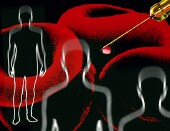 |
 |
 |

Higher Chemo Drug Dose Prolongs Lives of Leukemia Patients
Side effects similar to those seen with standard dose of daunorubicin, study shows|
|
HealthDay
By Robert Preidt
Thursday, December 4, 2008
 THURSDAY, Dec. 4 (HealthDay News) -- A high dose of the chemotherapy drug daunorubicin prolonged survival for patients with previously untreated acute myeloid leukemia (AML), preliminary results of a study sponsored by the U.S. National Cancer Institute (NCI) show.
THURSDAY, Dec. 4 (HealthDay News) -- A high dose of the chemotherapy drug daunorubicin prolonged survival for patients with previously untreated acute myeloid leukemia (AML), preliminary results of a study sponsored by the U.S. National Cancer Institute (NCI) show.
AML is a cancer of the blood and bone marrow. This study included 633 patients, aged 16 to 60, who were randomly assigned to receive either high-dose or standard-dose daunorubicin.
Both doses were given in combination with another chemotherapy drug called ara-C (cytarabine). The patients in the high-dose group received 90 milligrams of daunorubicin per square meter of body surface area (90 mg/m2) on each of the first three days of treatment. The standard dose is 45 mg/m2.
Patients in the high-dose group had a median overall survival of 23.7 months, compared to 15.1 months for those in the standard-dose group. Both groups had similar frequencies of serious treatment-related toxicity, according to the study, conducted by a network of researchers led by the Eastern Cooperative Oncology Group (ECOG).
"The findings of this large clinical trial are important, because they will likely change practice and improve the outcome for many patients with AML," Dr. Martin Tallman, chairman of the ECOG leukemia committee and a professor of medicine at Northwestern University Feinberg School of Medicine and the Robert H. Lurie Comprehensive Cancer Center in Chicago, said in an NCI news release.
Daunorubicin is already FDA-approved for treatment of AML, which means that patients with the disease may gain immediate benefit from the findings.
More than 13,000 people in the United States will be diagnosed with AML in 2008. Most cases occur in adults, and about half occur in those younger than 60. Only about one-third of AML patients survive the disease, and the odds of survival decrease with age.
HealthDay
Copyright (c) 2008 ScoutNews, LLC. All rights reserved.
Related News:
More News on this Date
Related MedlinePlus Pages:
| Home | Health Topics | Drugs & Supplements | Encyclopedia | Dictionary | News | Directories | Other Resources | |
| Disclaimers | Copyright | Privacy | Accessibility | Quality Guidelines U.S. National Library of Medicine, 8600 Rockville Pike, Bethesda, MD 20894 National Institutes of Health | Department of Health & Human Services |
Date last updated: 05 December 2008 |




